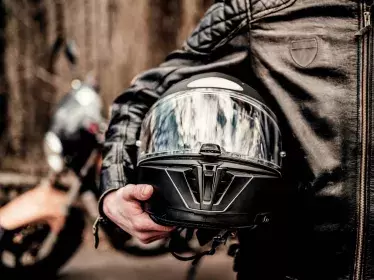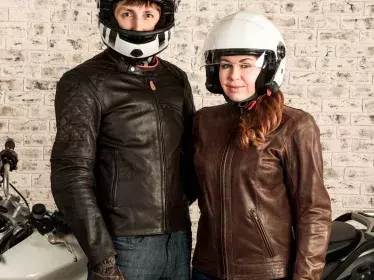Whatever you're riding (motorbike, scooter, two or three-wheeler), you need a good helmet. Safety is the most important criterion. A badly fitting helmet can very quickly cause a very real problem. If you choose the correct one, however, it will always be comfortable when you wear it.
ECE Label
Let's start at the beginning: only one type of helmet guarantees sufficient protection, the one that meets the E(EC)2205 standard. All other models have features that at the very least, are dubious in terms of efficiency.
By law, you cannot ride unless you wear an approved helmet (ECE approved). This makes sense since each ECE helmet is tested on a series of points. These are tests that can guarantee the safety of the wearer if the results are positive.
The helmet should fit snugly but not too tightly. When buying one, remember that the inner trim will shrink slightly when you start wearing the helmet.
You should preferably choose a bright or light colour so you can be seen in traffic.
Size
Whichever type of helmet you choose, the right size is very important. The size is expressed by a code composed of numbers and letters. The letters range from Extra Extra Small to Extra Large. The number code represents the circumference of the head, measured with a tape measure just above the ears. Of course, this is just an indication. You need to try on the helmet to see if it feels right. As with clothing, sizes vary from brand to brand and from model to model. Ask your dealer for advice on how to choose the right one.
Chin rest
Another important safety factor is ensuring the correct tension of the chin rest when the helmet is put on. Without this, it's possible that the helmet will fall off your head in the event of a fall or collision. It's simple to check if the tension is right: see if you can slide a finger between the chin rest and where it touches the body. If so, it fits properly.
Jet helmet
A jet helmet is an open-faced helmet that means your whole face remains uncovered. For this reason, it only provides limited protection. In the event of a fall or impact, face or chin injuries may occur. Jet helmets also don't protect your eyes unless they have a retractable visor. So if you choose this type of model, you should also wear effective and unbreakable eye protection, i.e. special safety glasses. When you're on the go, every stone and every insect becomes a projectile that shouldn't go anywhere near your eye.
(Moto)cross helmets
Cross helmets are specially designed for off-road use. Their shape and construction make them less suitable for use in normal road traffic. Their lack of aerodynamics is not suitable for travelling at high speeds, and they should be worn with motocross eye glasses to protect your eyes.
Full-face helmet
As the name implies, a full-face helmet protects the head and face. It offers a very high level of safety. Even when the visor is lowered, the integrated ventilation system allows sufficient air to enter. Modern visors have an anti-fog layer to maintain good visibility in the event of temperature fluctuations. However, it's always best to use a special inner visor, which very effectively prevents fogging.
Modular helmet
Modular helmets are fully closed. They fully protect the user's head. Like full-face helmets, they have built-in ventilation and a retractable visor. They can also be equipped with interior anti-fog protection if you want to continue to see well in winter conditions.
However, the chin part of a modular helmet also retracts. This means that when you're at a standstill, you'll be able to communicate more easily with others, read a map, take photos and look around without removing your hat.
However, driving with the chin section raised is strongly discouraged. First of all, it will catch the wind and put unnecessary stress on the vertebrae in your neck. Secondly, this component may suddenly fall down if it's not properly secured and this may disorientate you.
Due to their construction, most modular helmets are heavier than full-face ones.
Weight
The comfort of a helmet is closely linked to how much it weighs. A helmet that is too heavy will strain muscles and neck ligaments. Of course, helmets are made to bear the weight of a head, which on average weighs around 5 kilos. It is therefore important not to place too much strain on these parts of the body. As the experts will tell you, a good helmet is neither extremely light nor exceptionally heavy, but has a well-placed centre of gravity.
Interior and Care
The interior of modern helmets are almost always removable and washable. The fabric, which is often antibacterial, also regulates the internal temperature.
Regularly clean both sides of the visor with a soft cloth dampened with lukewarm water or a special cleaning agent. Avoid household care products: they usually contain alcohol and other detergents that can degrade the protective power of the visor. Sometimes they can cause it to become brittle, which can cause serious damage to face and eyes. A scratched visor will significantly reduce visibility and should be immediately replaced.
When should I replace my helmet?
Always replace your helmet after a fall or accident. This is because the structure is probably no longer intact. To understand how that has happened, you need to know what a helmet is made of.
The outer shell surrounds a softer inner layer. When the helmet comes into contact with another object, the outer shell briefly presses on the inner layer. This remains deformed, even if the exterior returns to its normal shape. As a result, the way in which the two layers work, both internally and externally, is weakened at the point of impact. This will compromise safety. The only safe solution is to change your helmet.






